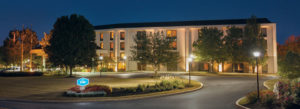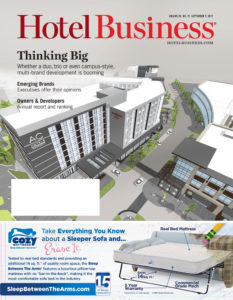LANCASTER, PA—With its entire portfolio located within roughly a four-hour drive from its headquarters here, High Hotels Ltd. is a perfect example of a local hotel owner and developer. The wholly owned subsidiary of the High Companies—a multifaceted group of businesses which began as a welding company run by founder Sanford High in 1931—owns 16 hotels [two are currently under construction]covering four states—Pennsylvania, New Jersey, Maryland and New York.
Once a hotel becomes part of the High Hotels family, it is likely to stay there for good. “We are a company that, by our nature, tends to hold long term,” said Russell Urban, president of High Hotels. “Everything we build, we build forever. We have a very long-term view on everything. We’re not opportunistic about how we expand, and we really don’t sell as a matter of course.”
He continued, “We believe in owning and operating hotels that are clustered. We believe in having, if we can, at least two hotels in a given market. It gives us added critical mass to operate the hotels.”
The current portfolio is made up of select-service and extended-stay brands in the Hilton and Marriott brand families, and nearly all are wholly owned. The one exception is the Lancaster Marriott at Penn Square, “which we own with a local partner, as part of a larger redevelopment plan with the [adjoining]Lancaster County Convention Center,” noted Urban. “That, I would say, is much more of a one-off than any strategy that we would employ in the future.”
The breakdown of Hilton vs. Marriott hotels is 50/50. Among the Hilton hotels are five Hampton Inns, including one in Lancaster (the company’s first hotel, located about an eighth of a mile from its headquarters); two Homewood Suites; and a Hilton Garden Inn. “I would say that we have great success in all three of those brands,” said Urban, who added, “We’re looking at a number of expansion opportunities particularly in Home2 Suites and Tru by Hilton.”
High Hotels’ Marriott-branded properties include six hotels under the flags of Courtyard by Marriott (including one in Middletown, NY, where the company also owns a Hampton Inn), SpringHill Suites and TownePlace Suites, and the aforementioned Marriott, plus two hotels that are under construction.
“We love Courtyards. I have a great affinity for that brand and its market positioning,” said Urban, who, back in the 1980s, was part of the Marriott development team when it first rolled out the Courtyard brand. “We also just opened our second Spring-Hill Suites in Mt. Laurel, NJ. We have a third one opening in December in Allentown, PA, in a new corporate park kind of submarket there. I would say that, obviously, you have to look at that and say we’re bullish on that.”
In the building stages is the company’s first Residence Inn, which will be located within a 90-acre mixed-use development adjacent to 258 multi-family units owned by the High Companies. “The development will also incorporate a Super Wegmans [a supermarket]and an additional 100,000 sq. ft. of lifestyle retail. We like doing those mixed-use projects. I would say that that’s a competitive advantage because we can do that within our own company. We don’t have to segment out the land and venture with other people. We can do it all ourselves. I think that’s going to be a strategy that you’ll see us employing over the next several years,” he said.
Somewhere down the line, High Hotels could look to another brand company to join Hilton and Marriott, according to Urban. “We clearly feel strongly about Marriott and Hilton as our preferred brand families at this point. However, we are looking at alternative brands to put in some markets, or maybe in markets where the two brand families are already saturated,” he said.
Urban joined High Hotels in November 2015 following a nearly three-year stint as EVP of business development and acquisitions at Denver-based Destination Hotels & Resorts. He has since brought on two key executives to help the company grow its portfolio.
“We’ve recently restructured the way we work,” said Urban. “David Aungst was promoted to VP of operations, so all of the hotels report to him. We’ve also brought on a very strong project management role here, for which I hired Gary Raymond, to help with the property improvement plans (PIPs) because we’ve got a long line of them that we do every single year in an effort to stay up with the brand requirements and to keep our products fresh.” Aungst previously served as controller and regional director in separate roles at High Hotels.
While the company usually holds onto properties once they are part of the portfolio, it is a rare occasion for a hotel to be sold off. “If we ever decide to sell an asset, which is infrequently, it’s only because we feel some concern about the geography and the marketplace,” said Urban.
He noted that there may be, in the coming years, some alterations of the company’s philosophy of owning hotels within a four-hour drive of its headquarters. “We have started a rather intense market evaluation. Our goal is to get to 25 hotels by 2025,” Urban said. “With that, I suspect we will stay within our four-hour radius for most of that, but we have begun to look at outside markets. We actually have done some reconnaissance in the Charleston, SC, area, and down on the West Coast of Florida. It’s been very early days there. Both of those markets, by the way, are markets where we have office, industrial and multi-family presence today.
“While we currently don’t have hotels in those markets, we do have an overall company infrastructure that would help us feel better about diversifying into those markets,” he continued. “I would say [expansion outside its four core states]is not a highly active effort right now. I think it’s more secondary to saturating our current markets.”
Urban said he feels strongly that his company is well-positioned “from our own capital, from market availability and brand availability” to achieve the goal of 25 hotels or more by 2025. Further on into the future, he noted, “I’m certainly working hard to position High Hotels as a more prominent player in the business. I could see, 25 years from now, being a larger, more diverse company in terms of broadening out to more brands and broadening in geography. I would say that it would be hard for me to believe that we’d move beyond our current model of owner-operator. I think we’re going to continue to own everything that we operate.” HB



